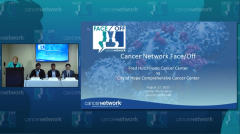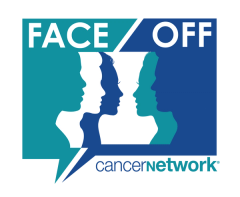
Olverembatinib in Ponatinib-Resistant CML: Considerations for Later-Line Therapy
Expert insight into the later-line efficacy and tolerability of olverembatinib, a third generation TKI, in ponatinib-resistant, refractory chronic myeloid leukemia populations.
Episodes in this series

Transcript:
Vivian G. Oehler, MD: So I’m going to present olverembatinib. And these are data that Dr Jabor presented at ASH [American Society of Hematology] at the December meeting in 2022. So olverembatinib is another third-generation TKI [tyrosine kinase inhibitor]. And I will say…it’s very potent and is active against…almost all mutations, as well as wild-type BCR-ABL. Similar to ponatinib, it also is not a clean drug. It’s got multiple other kinases that it targets, including KIT, PDGFR, SERC, FGFR, and FLT3. I will say that it is the equivalent of FDA-approved in China by the China NMPA based on data in their own clinical trials in CP [chronic phase] and AP-CML [acute phase chronic myeloid leukemia].
In order to get a drug approval in the US, we have to run a study to obtain PK [pharmokinetic response] in a North American population. And so, the study that Dr Koller and I are both involved with is a phase 1 study with a primary end point of PK. Key secondary end points are safety and efficacy. This is a study in the second line and beyond. Again, we excluded patients in chronic phase who have complete cytogenetic response. So these are not the good responders. Patients were [randomly assigned 3:2] to olverembatinib at 30 mg, 40 mg, and 50 mg every other day. It’s a drug with a very long half-life. And for this presentation, we have 51 patients.
These are some of the patient characteristics across the arm. You can see the median age is in the 50s for the overall group…a little bit younger than we sometimes see in our own populations. Very common on trial. Again, a lot of these patients had at least 1 cardiovascular comorbidity. So this was 55% of patients, and 35% of patients had hypertension. This was a heavily pretreated group. As you can see, 50% of the patients had 3 or more salvage attempts. Many patients were treated with ponatinib, so 55% across the group, and 75% of those were resistant to ponatinib and 25% [were] intolerant of ponatinib.
So I show here the responses by each of these individual cohorts in the patients. And so, at left, we’ve got it by dose. In the middle, if you were intolerant or resistant to ponatinib. And at the right, based on T315I mutation. Across the chronic phase group, you can see there was excellent efficacy, complete cytogenetic response [of] 77% [and] MMR, major molecular response, [of] 43%. What I think is intriguing was the efficacy in ponatinib failures, which I could say I was not sure we would see that. And for ponatinib-resistant, I know it’s a small group, but we saw 77.8% complete cytogenetic response and 50% for MMR, and high efficacy in T315I-mutated patients.
The drug was very well-tolerated with regard to nonhematologic toxicities for the most part. And those [nonhematologic] toxicities were elevated CK [creatine kinase], transaminase elevations, fatigue, some GI [gastrointestinal] symptoms. Again, similar to the asciminib data, we did see a number of hematologic toxicities. These are very common in patients on later-line therapy with thrombocytopenia in all-comers at 29.7%. So far, and this needs to be followed up on very closely, the rate of AOEs [arterial occlusion events] appears to be low with limited follow-up, and 11 patients discontinued. So why did they discontinue so far? Thrombocytopenia and leukopenia in 1, worsening vascular issues in a patient with cardiac history…disease progression in 3, and 2 patients also switched to transplant.
So, early data. I’m going to say we are seeing efficacy and refractory CP-CML, both in what I didn’t show in advanced-phase CML and pH-positive ALL [acute lymphocytic leukemia], as well as patients with T315I mutations. And what I think is intriguing is the efficacy, and this might actually speak to its role in later line therapy and ponatinib-resistant patients. A little bit surprisingly, we saw a similar PK profile between China and US patient populations, which was actually the primary end point.
I have to ask this question. It’s too early to really know. I think personally that we do actually need potent drugs. Yes, most patients do well, but there’s always this group of patients [where] you might think, how many drugs could you possibly need for CML when there’s only 8000 people in the US diagnosed annually? But treating that group of patients who…might not be able to get to transplant, really you need something. I think asciminib, we’re going to see this moving up [to] earlier lines of therapy. Second [line], frontline. It’s a very potent drug, it’s well-tolerated. But olverembatinib, I see this drug actually coming in the ponatinib-resistant populations. And then…if it has a high AOE rate, well, it might…who knows? But if it has a lower AOE rate, although I wouldn’t understand necessarily mechanistically why that would be, then perhaps that would be a preferred third-line therapy when one does a risk-and-benefit analysis. But [it’s] too early to say.
Transcript is AI-generated and edited for clarity and readability.
Newsletter
Stay up to date on recent advances in the multidisciplinary approach to cancer.




















































































